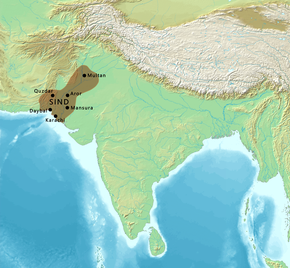Sind سنڌ | |||||||||||
|---|---|---|---|---|---|---|---|---|---|---|---|
| 711–861 | |||||||||||
| Capital | Aror | ||||||||||
| Common languages | Sindhi, Sanskrit, Arabic | ||||||||||
| Religion | State religion: | ||||||||||
| Government | Caliphal province | ||||||||||
| Governor | |||||||||||
• 711– 715 (first) | Muhammad bin Qasim | ||||||||||
• 854– 861 (last) | Umar ibn'Abd al-Aziz al'Habbari | ||||||||||
| History | |||||||||||
| 711 | |||||||||||
| 861 | |||||||||||
| |||||||||||
| Today part of | Pakistan, small parts of India | ||||||||||
Sind (Arabic: سند, Urdu & Sindhi: سنڌ) was an administrative division of the Umayyad Caliphate and later of the Abbasid Caliphate in post-classical India, from around 711 CE with the Umayyad conquest of Sindh by the Arab military commander Muhammad ibn al-Qasim, to around 854 CE with the emergence of the independent dynasties of the Habbarid Emirate in Sindh proper and the Emirate of Multan in Punjab. The "Governor of Sind" (Arabic: عامل السند, romanized: ‘āmil al-Sind)[2] was an official who administered the caliphal province over what are now Sindh, southern Punjab and Makran (Balochistan) in Pakistan.
The governor was the chief Muslim official in the province and was responsible for maintaining security in the region. As the leader of the provincial military, he was also in charge of carrying out campaigns against the non-Muslim kingdoms of India. Governors appointed to the region were selected either directly by the caliph or by an authorized subordinate, and remained in office until they either died or were dismissed.
- ^ Schwartzberg, Joseph E. (1978). A Historical atlas of South Asia. Chicago: University of Chicago Press. p. 145, map XIV.1 (e). ISBN 0226742210.
- ^ Al-Ya'qubi, pp. 388, 557, 448, 599; al-Tabari, v. 32: p. 106

